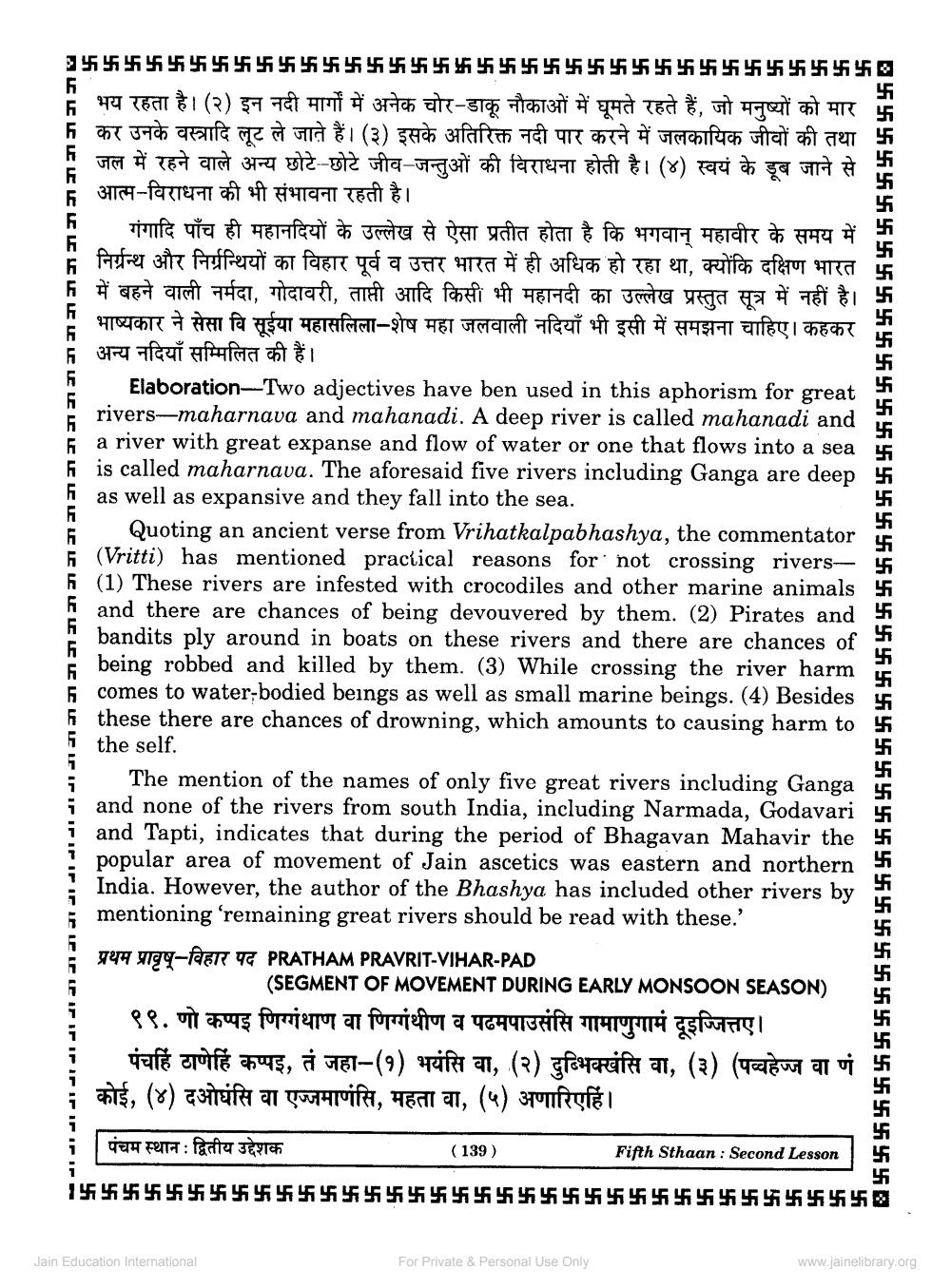________________
समाजमा गागागागाना गगगगगगग गगगगा
95555555555555555555555555555555555555 A भय रहता है। (२) इन नदी मार्गों में अनेक चोर-डाकू नौकाओं में घूमते रहते हैं, जो मनुष्यों को मार । कर उनके वस्त्रादि लूट ले जाते हैं। (३) इसके अतिरिक्त नदी पार करने में जलकायिक जीवों की तथा ॥
जल में रहने वाले अन्य छोटे-छोटे जीव-जन्तुओं की विराधना होती है। (४) स्वयं के डूब जाने से # आत्म-विराधना की भी संभावना रहती है। म गंगादि पाँच ही महानदियों के उल्लेख से ऐसा प्रतीत होता है कि भगवान् महावीर के समय में - निर्ग्रन्थ और निर्ग्रन्थियों का विहार पूर्व व उत्तर भारत में ही अधिक हो रहा था, क्योंकि दक्षिण भारत । में बहने वाली नर्मदा, गोदावरी, ताप्ती आदि किसी भी महानदी का उल्लेख प्रस्तुत सूत्र में नहीं है।
भाष्यकार ने सेसा वि सूईया महासलिला-शेष महा जलवाली नदियाँ भी इसी में समझना चाहिए। कहकर अन्य नदियाँ सम्मिलित की हैं।
Elaboration–Two adjectives have ben used in this aphorism for great rivers-maharnava and mahanadi. A deep river is called mahanadi and
a river with great expanse and flow of water or one that flows into a sea F is called maharnava. The aforesaid five rivers including Ganga are deep F as well as expansive and they fall into the sea.
Quoting an ancient verse from Vrihatkalpabhashya, the commentator (Vritti) has mentioned practical reasons for not crossing riversF (1) These rivers are infested with crocodiles and other marine animals
and there are chances of being devouvered by them. (2) Pirates and bandits ply around in boats on these rivers and there are chances of being robbed and killed by them. (3) While crossing the river harm
comes to water-bodied beings as well as small marine beings. (4) Besides h these there are chances of drowning, which amounts to causing harm to 5 the self.
The mention of the names of only five great rivers including Ganga and none of the rivers from south India, including Narmada, Godavari i and Tapti, indicates that during the period of Bhagavan Mahavir the
popular area of movement of Jain ascetics was eastern and northern India. However, the author of the Bhashya has included other rivers by mentioning ‘remaining great rivers should be read with these.'
855555555555555555555555555 5 5555555555555555555555
IP IR IF IC II IPIRIPIPI
प्रथम प्रावृष-विहार पद PRATHAM PRAVRIT-VIHAR-PAD
(SEGMENT OF MOVEMENT DURING EARLY MONSOON SEASON) ९९. णो कप्पइ णिगंथाण वा णिगंथीण व पढमपाउसंसि गामाणुगामं दूइज्जित्तए। पंचहिं ठाणेहिं कप्पइ, तं जहा-(१) भयंसि वा, (२) दुभिक्खंसि वा, (३) (पव्वहेज वा णं कोई, (४) दओघंसि वा एज्जमाणंसि, महता वा, (५) अणारिएहिं।
पंचम स्थान : द्वितीय उद्देशक
(139)
Fifth Sthaan : Second Lesson
Jain Education International
For Private & Personal Use Only
www.jainelibrary.org




